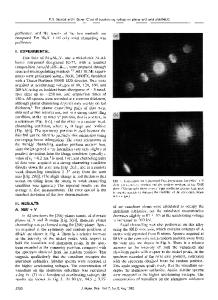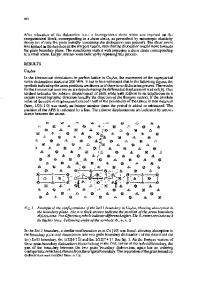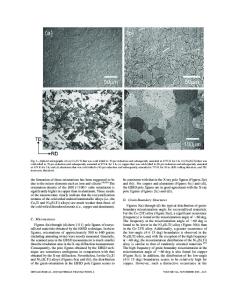The Effect of Extended Superdislocation / Domain Boundary Interactions in Ordered Intermetallic Compounds
- PDF / 69,255 Bytes
- 6 Pages / 612 x 792 pts (letter) Page_size
- 75 Downloads / 320 Views
The Effect Of Extended Superdislocation / Domain Boundary Interactions in Ordered Intermetallic Compounds Tie-Sheng Rong*, Mark Aindow** and Ian P. Jones* *School of Metallurgy & Materials, The University of Birmingham, Birmingham B15 2TT, U.K. **Department of Metallurgy and Materials Engineering, Institute of Materials Science, University of Connecticut, Storrs, CT 06269-3136, USA ABSTRACT It has been known for many years that the presence of a distribution of domain boundaries in crystals with ordered superlattice structures can affect both the separation of glissile superpartial dislocations and the yield stress. Based on the details of the interactions between the domain boundaries and glissile extended superdislocations, we incorporate the effects of the thin band of perfect crystal that arises when coupled superpartial dislocations straddle a domain boundary, and the additional domain boundary area created once the whole superdislocation has passed through. If these effects are included then, in an ordered phase containing many domains, we would expect the equilibrium separation of the coupled superpartial dislocations to vary more significantly with domain size than is predicted by previous models. These effects also change the way in which yield stress is predicted to vary with domain size. This variation gives a much better match to published experimental data than existing models. INTRODUCTION In ordered structures, if an ordering process commences at different places, different ’phases’ or ’domains’ of the same ordered phase nucleate and grow. Wherever these domains meet, anti-phase domain boundaries (APDBs) are created. Ribbons of anti-phase domain boundary (APB) can also be formed by the dissociation of superdislocations, where the equilibrium separation of the superpartial dislocations is determined by the character of the dislocations and the APB energy. For the purposes of this paper we will consider only glide dissociations and will refer to the engendered APBs as shear anti-phase boundaries (SAPBs) although we note that climb dissociations are also common at elevated temperatures In most calculations of the equilibrium separation for coupled superpartial dislocations the effects of APDBs are neglected, i.e. it is assumed that the phase in which the extended superdislocation resides consists of a single ordered domain. If, however, the phase consists of multiple domains then, as shown by Marcinkowski and Fisher [1], the effect of APDB thickness is to make the separation of coupled superpartial dislocations dependent on the APD size. This effect would become significant for domain sizes of less than about 10nm. In this paper, we consider the ways in which the superpartial dislocations interact with the APDBs and the possible effects of these interactions. It is shown that when these interactions are taken into account, one would expect a significant additional effect on both the separation of coupled superpartial dislocations and on the yield stress. Moreover, it is shown that the yield stresses pred
Data Loading...











